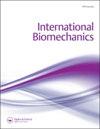Asymmetry and evolution over a one-year period of the upward rotation of the scapula in youth baseball pitchers
Q2 Medicine
引用次数: 0
Abstract
ABSTRACT The pitching motion is an asymmetric action by which coordination of scapular rotation in the dominant arm might be affected in time and in comparison with the non-dominant arm. The study aimed to compare asymmetry and the evolution of scapular upward rotation over a one-year period. Data were collected twice, before and after a one-year period, from 92 participants (age = 15.1 SD 1.4 years, body height = 177.3 SD 10.9 cm, body weight 69.2 SD 14.5 kg). Scapular motion was tracked at different glenohumeral angles of elevation in the scapular plane: anatomical position (0°), 45°, 90° and 135°. Scapular upward rotation was calculated as the angle between the spinae scapula and the spine. Scapular upward rotation of the dominant arm was 5.1° (95% CI: 2.1°−8.1°) more compared to the non-dominant arm. Age group or glenohumeral angles of elevation did not affect this difference. Scapular upward rotation of the dominant arm decreased 1.9° (95% CI: −0.5° to 4.3°) after a one-year period, however, neither this observation, nor the interaction with age group or elevation angle was significant. These findings may indicate that pitchers could be at risk to develop shoulder injuries especially those that have been associated with scapular asymmetry.青年棒球投手肩胛骨向上旋转一年的不对称性和进化
俯仰运动是一种不对称动作,与非优势臂相比,优势臂肩胛骨旋转的协调性可能在时间上受到影响。该研究旨在比较一年期间肩胛骨不对称和肩胛骨向上旋转的演变。92名参与者(年龄= 15.1 SD 1.4岁,身高= 177.3 SD 10.9 cm,体重= 69.2 SD 14.5 kg)在一年前和一年后收集了两次数据。在不同的肩胛骨平面上的肩胛骨上仰角:解剖位置(0°),45°,90°和135°,跟踪肩胛骨运动。肩胛骨向上旋转计算为肩胛骨与脊柱之间的角度。与非优势臂相比,优势臂的肩胛骨向上旋转多5.1°(95% CI: 2.1°- 8.1°)。年龄组和肩关节上仰角度对这种差异没有影响。一年后,主臂肩胛骨向上旋转减少1.9°(95% CI: - 0.5°至4.3°),然而,这一观察结果以及与年龄组或仰角的相互作用都不显著。这些发现可能表明投手可能有肩部损伤的风险,特别是那些与肩胛骨不对称有关的风险。
本文章由计算机程序翻译,如有差异,请以英文原文为准。
求助全文
约1分钟内获得全文
求助全文
来源期刊

International Biomechanics
Medicine-Rehabilitation
CiteScore
1.90
自引率
0.00%
发文量
2
审稿时长
17 weeks
期刊介绍:
International Biomechanics is a fully Open Access biomechanics journal that aims to foster innovation, debate and collaboration across the full spectrum of biomechanics. We publish original articles, reviews, and short communications in all areas of biomechanics and welcome papers that explore: Bio-fluid mechanics, Continuum Biomechanics, Biotribology, Cellular Biomechanics, Mechanobiology, Mechano-transduction, Tissue Mechanics, Comparative Biomechanics and Functional Anatomy, Allometry, Animal locomotion in biomechanics, Gait analysis in biomechanics, Musculoskeletal and Orthopaedic Biomechanics, Cardiovascular Biomechanics, Plant Biomechanics, Injury Biomechanics, Impact Biomechanics, Sport and Exercise Biomechanics, Kinesiology, Rehabilitation in biomechanics, Quantitative Ergonomics, Human Factors engineering, Occupational Biomechanics, Developmental Biomechanics.
 求助内容:
求助内容: 应助结果提醒方式:
应助结果提醒方式:


